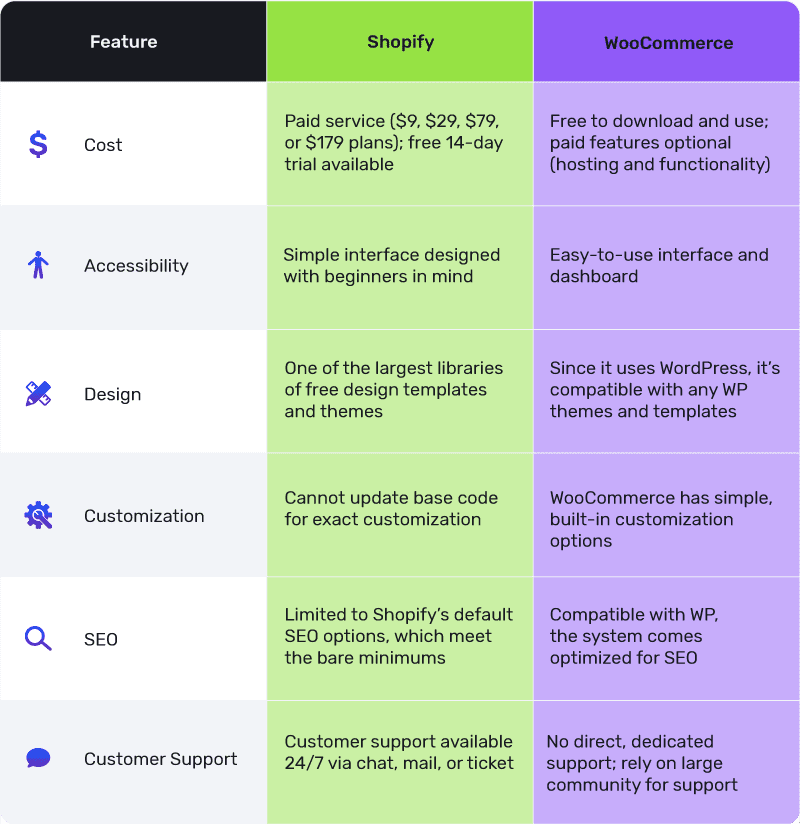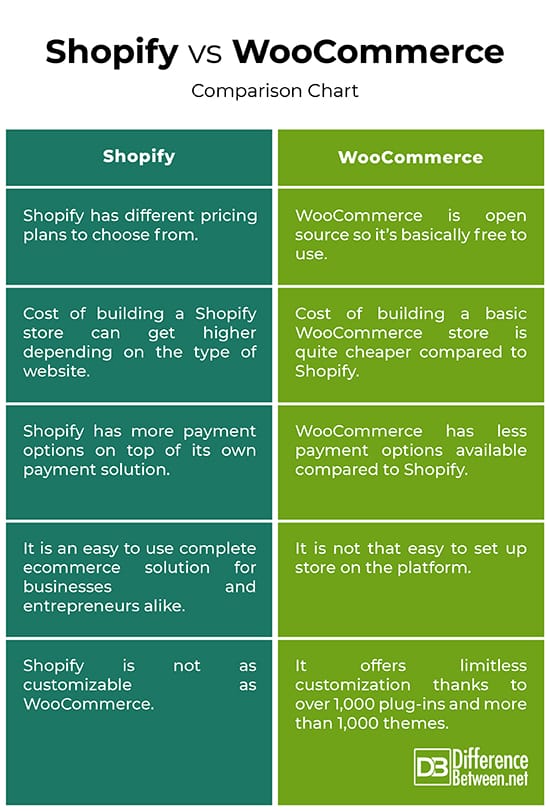Shopify and WooCommerce are two popular e-commerce platforms. Both help you create an online store, but they have key differences.
Understanding these differences is crucial for choosing the right platform for your business. Shopify is an all-in-one solution with a monthly fee. It includes hosting, security, and support. WooCommerce is a plugin for WordPress. It offers more flexibility but requires more technical knowledge.
Click Here To Get Promo Code & Full Shopify Review With Extra Bonuses
In this blog post, we will explore the main differences between Shopify and WooCommerce. This will help you decide which platform best suits your needs. Let’s dive into the details and find the perfect fit for your online store.
Ease Of Use
When choosing between Shopify and WooCommerce, ease of use is a key factor. How easy it is to set up and manage your online store can make a big difference. This section breaks down the user experience and setup process for both platforms.
User Experience
Shopify offers a user-friendly experience. Its dashboard is intuitive and easy to navigate. Everything you need is just a click away. You can manage products, orders, and customers from a single interface.
WooCommerce integrates with WordPress. This means you need some familiarity with WordPress. The dashboard is less centralized. You manage WooCommerce settings and products from the WordPress admin panel. This can be confusing for beginners.
Setup Process
Setting up Shopify is straightforward. You sign up, choose a plan, and start building your store. Shopify provides a range of themes. You can customize them without touching any code. The platform handles hosting and security for you.
Setting up WooCommerce requires more steps. First, you need a WordPress site. Then you install the WooCommerce plugin. You also need to choose a hosting provider. This can be tricky for beginners. Customizing your store may require some coding knowledge.

Credit: exposureninja.com
Pricing
Choosing between Shopify and WooCommerce often comes down to pricing. Both platforms offer different cost structures. This can impact your budget and long-term investment. Let’s break down the costs involved.
Subscription Costs
Shopify offers tiered pricing plans. These range from $29 to $299 per month. Each plan provides different features and support levels. The basic plan covers essential tools. The advanced plan includes more specialized features.
WooCommerce, on the other hand, is free to use. But, you need to pay for hosting. Hosting costs can range from $5 to $25 per month. Some premium themes and plugins may also require payment. These costs can add up over time.
Additional Fees
Shopify charges transaction fees. These range from 2.9% + 30¢ to 2.4% + 30¢ per transaction. The fee depends on your subscription plan. Using Shopify Payments can reduce these fees. But, other payment gateways might have extra costs.
WooCommerce does not charge transaction fees. But, you might pay for payment gateway integrations. Some gateways charge their own fees. These can vary depending on the provider. This gives you more control over your costs.
Customization
Customization is a key factor for any online store. The ability to tailor your e-commerce platform to match your brand and meet unique requirements is essential. Both Shopify and WooCommerce offer various customization options, but they differ significantly in their approaches and capabilities. Let’s explore these differences under the subheadings Themes and Templates and Plugins and Extensions.
Themes And Templates
Shopify provides a variety of professionally designed themes. These themes are easy to customize without coding knowledge. You can find free and paid themes in the Shopify Theme Store. Each theme comes with customization options, allowing you to change colors, fonts, and layouts.
WooCommerce offers a vast selection of themes through WordPress. Many themes are free, and premium themes are available from various marketplaces. WooCommerce themes are highly customizable. You can modify them using the WordPress Customizer or child themes. This requires some knowledge of HTML, CSS, and PHP.
Plugins And Extensions
Shopify has an extensive App Store with numerous plugins and extensions. These apps add extra features to your store. Installation is straightforward, and most apps integrate seamlessly with your store. Some popular apps include SEO tools, email marketing, and social media integrations.
WooCommerce relies on WordPress plugins for additional functionality. There are thousands of plugins available, both free and paid. These plugins cover various needs, from SEO optimization to advanced shipping methods. Customizing WooCommerce with plugins may require technical skills, but it offers greater flexibility.

Credit: www.bolt.com
Payment Options
Choosing the right payment options for your online store is crucial. Both Shopify and WooCommerce offer a variety of payment gateways. Understanding the differences can help you decide which platform best suits your needs.
Supported Payment Gateways
Both Shopify and WooCommerce support numerous payment gateways. This variety gives you flexibility in how you accept payments from customers.
| Platform | Supported Payment Gateways |
|---|---|
| Shopify |
|
| WooCommerce |
|
Transaction Fees
Transaction fees are another important factor to consider. These fees can impact your profit margins.
- Shopify: Charges 2.9% + 30¢ per transaction if using Shopify Payments. Additional 2% fee if using external gateways like PayPal or Stripe.
- WooCommerce: Does not charge additional transaction fees beyond those of the payment gateways. PayPal and Stripe typically charge 2.9% + 30¢ per transaction.
Key Takeaway: Shopify offers a range of integrated payment options with added fees for external gateways. WooCommerce provides more flexibility with no extra transaction fees beyond those charged by the payment gateways.
Seo Capabilities
Understanding the SEO Capabilities of Shopify and WooCommerce is essential. Both platforms offer unique features to help your online store rank better in search engines. Let’s explore their built-in tools and third-party plugins.
Built-in Seo Tools
Shopify provides several built-in SEO tools. These tools help you optimize your store without extra costs. Shopify allows you to edit meta titles and descriptions easily. It also creates a clean URL structure automatically. This structure improves your site’s visibility on search engines.
WooCommerce offers fewer built-in SEO features. To optimize your store, you need to use WordPress capabilities. This includes editing permalinks and adding meta tags. However, WooCommerce provides flexibility in customization. You can edit almost every part of your store for better SEO.
Third-party Seo Plugins
Shopify supports various third-party SEO apps. Some popular options include Plug in SEO and SEO Manager. These apps offer advanced SEO features. They help you with keyword suggestions, SEO audits, and more.
WooCommerce benefits from the vast WordPress plugin ecosystem. The most popular SEO plugin is Yoast SEO. Yoast provides comprehensive SEO tools. These tools include XML sitemaps, meta tag management, and readability analysis.
Another excellent WooCommerce plugin is All in One SEO. This plugin helps with on-page SEO and social media integration. The flexibility and range of plugins in WooCommerce give you more control over your SEO efforts.
| Feature | Shopify | WooCommerce |
|---|---|---|
| Built-in SEO Tools | Yes, limited | Yes, extensive via WordPress |
| Third-Party Plugins | Yes, available in the app store | Yes, extensive options |
| Customization | Limited | High |

Credit: naturaily.com
Security
Security is a vital aspect of any eCommerce platform. Both Shopify and WooCommerce offer robust security features to protect your online store. Understanding the differences in their security measures can help you make an informed decision.
Data Protection
Shopify handles data protection by providing built-in SSL certificates for all stores. This ensures that customer data is encrypted and secure. Shopify also performs regular security updates and monitoring to protect against threats.
WooCommerce, on the other hand, relies on WordPress security. You need to install SSL certificates yourself. You also need to ensure that your hosting provider offers security features. WooCommerce requires regular updates and monitoring to maintain security.
Compliance
Shopify is PCI DSS Level 1 compliant by default. This compliance ensures that Shopify meets the highest security standards. It handles credit card information safely. Shopify also provides GDPR compliance tools to help you manage data privacy regulations.
WooCommerce requires manual setup for PCI DSS compliance. You need to configure your store and hosting to meet these standards. WooCommerce offers GDPR compliance features, but you need to install plugins and configure settings to ensure compliance.
| Aspect | Shopify | WooCommerce |
|---|---|---|
| SSL Certificates | Built-in | Manual installation |
| PCI DSS Compliance | Default | Manual setup |
| GDPR Compliance | Built-in tools | Plugins required |
Shopify offers a more streamlined security setup. WooCommerce provides flexibility but requires more manual management.
Customer Support
Understanding customer support options is crucial for choosing between Shopify and WooCommerce. This section will help you decide which platform offers better support for your needs.
Support Channels
Shopify provides multiple support channels. These include:
- 24/7 live chat
- Email support
- Phone support
This ensures you can get help any time you need it.
WooCommerce, being an open-source platform, has a different approach. You can find:
- Email support through ticketing system
- Support from your hosting provider
Support availability may vary depending on your hosting service.
Community Help
Shopify has a large, active community. The Shopify Community Forum offers:
- Discussion boards
- Guides and tutorials
- Help from other Shopify users
You can also access the Shopify Help Center for additional resources.
WooCommerce also boasts a strong community. The WooCommerce Community Forum provides:
- Discussion boards
- Extensive documentation
- Support from other WooCommerce users
Many developers contribute to the community, offering plugins and solutions.
Both platforms have robust support options. Your choice may depend on your preference for direct support or community help.
Frequently Asked Questions
What Is Shopify?
Shopify is a hosted e-commerce platform. It offers a complete solution for online stores. Shopify includes hosting, security, and software updates.
What Is Woocommerce?
WooCommerce is a WordPress plugin. It transforms WordPress into an online store. WooCommerce is self-hosted and customizable.
Which Is Easier To Use?
Shopify is generally easier to use. It offers a user-friendly interface. WooCommerce requires more technical knowledge.
Which Is More Customizable?
WooCommerce is more customizable. It offers extensive plugins and themes. Shopify has customization limits.
Conclusion
Choosing between Shopify and WooCommerce depends on your needs. Shopify offers simplicity and support. WooCommerce provides flexibility and customization. Both platforms have strengths. Consider your budget and technical skills. Shopify suits beginners and small businesses. WooCommerce is great for larger, complex stores.
Evaluate your priorities. Make an informed decision. Start building your online store today.

